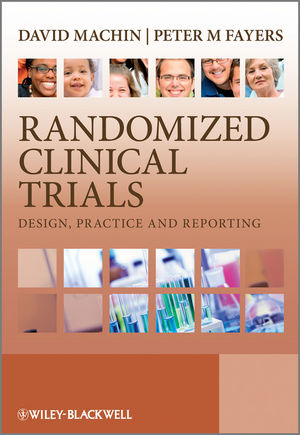
Randomized Clinical Trials
Wiley-Blackwell (an imprint of John Wiley & Sons Ltd) (Verlag)
978-0-471-49812-4 (ISBN)
- Titel erscheint in neuer Auflage
- Artikel merken
Using examples and case studies from industry, academia andresearch literature, Randomized Clinical Trials provides adetailed overview of the key issues involved in designing,conducting, analysing and reporting randomized clinicaltrials. It examines the methodology for conducting Phase IIIclinical trials, developing the protocols, the practice forcapturing, measuring, and analysing the resulting clinical data andtheir subsequent reporting. Randomized clinical trials are the principal method fordetermining the relative efficacy and safety of alternativetreatments, interventions or medical devices. They areconducted by groups comprising one or more of pharmaceutical andallied health-care organisations, academic institutions, andcharity supported research groups. In many cases such trialsprovide the key evidence necessary for the regulatory approval of anew product for future patient use. Randomized ClinicalTrials provides comprehensive coverage of such trials, rangingfrom elementary to advanced level.
Written by authors with considerable experience of clinicaltrials, Randomized Clinical Trials is an authoritative guidefor clinicians, nurses, data managers and medical statisticiansinvolved in clinical trials research and for health careprofessionals directly involved in patient care in a clinical trialcontext.
David Machin, Medical Statistics Group, School of Health andRelated Sciences, University of Sheffield, UK and Children's Cancerand Leukaemia Group, University of Leicester, UK Peter M Fayers, Department of Public Health, Universityof Aberdeen, UK and Faculty of Medicine, Norwegian University ofScience and Technology, Trondheim, Norway
Preface. 1 Introduction. 1.1 Introduction. 1.2 Some completed trials. 1.3 Choice of design. 1.4 Practical constraints. 1.5 Influencing clinical practice. 1.6 History. 1.7 How trials arise. 1.8 Ethical considerations. 1.9 Regulatory requirements. 1.10 Focus. 1.11 Further reading. 2 Design Features. 2.1 Introduction. 2.2 The research question. 2.3 Patient selection. 2.4 The consent process. 2.5 Choice of interventions. 2.6 Choice of design. 2.7 Assigning the interventions. 2.8 Making the assessments. 2.9 Analysis and reporting. 2.10 Technical details. 2.11 Guidelines. 2.12 Further reading. 3 The Trial Protocol. 3.1 Introduction. 3.2 Protocol abstract. 3.3 Protocol background. 3.4 Protocol research objectives. 3.5 Protocol design. 3.6 Protocol intervention details. 3.7 Protocol eligibility. 3.8 Protocol randomization. 3.9 Protocol assessment and data collection. 3.10 Protocol statistical considerations. 3.11 Protocol ethical issues. 3.12 Protocol organizational structure. 3.13 Protocol publication policy. 3.14 Protocol trial forms. 3.15 Protocol appendices. 3.16 Regulatory requirements. 3.17 Guidelines. 3.18 Protocols. 4 Measurement and Data Capture. 4.1 Introduction. 4.2 Measures and endpoints. 4.3 Making the observations. 4.4 Baseline measures. 4.5 Types of measures. 4.6 Data recording. 4.7 Technical notes. 4.8 Guidelines. 5 Randomization. 5.1 Introduction. 5.2 Rationale. 5.3 Mechanics. 5.4 Application. 5.5 Carrying out randomization. 5.6 Documentation. 5.7 Unacceptable methods. 5.8 Software. 5.9 Guidelines. 6 Trial Initiation. 6.1 Introduction. 6.2 Trial organization. 6.3 Data collection and processing. 6.4 Data monitoring. 6.5 Ethical and regulatory requirements. 6.6 Launching the trial. 6.7 Trial registries. 6.8 Guidelines. 7 Trial Conduct. 7.1 Introduction. 7.2 Regular feedback. 7.3 Publicity. 7.4 Data monitoring committees. 7.5 Protocol modifications. 7.6 Preparing the publication(s). 7.7 The next trial? 7.8 Protocols. 8 Basics of Analysis. 8.1 Introduction. 8.2 Confidence intervals. 8.3 Statistical tests. 8.4 Examples of analysis. 8.5 Other issues. 8.6 Practice. 8.7 Technical details. 9 Trial Size. 9.1 Introduction. 9.2 Significance level and power. 9.3 The fundamental equation. 9.4 Specific situations. 9.5 Practical considerations. 9.6 Further topics. 9.7 Other methods and software. 9.8 Guideline. 10 Reporting. 10.1 Introduction. 10.2 Publication guidelines. 10.3 Responsibilities. 10.4 Background. 10.5 Methods. 10.6 Findings. 10.7 When things go wrong. 10.8 Conclusions. 10.9 Guidelines. 11 Adaptations of the Basic Design. 11.1 Introduction. 11.2 Repeated measures. 11.3 Cluster-randomized trials. 11.4 Non-inferiority trials. 11.5 Guidelines. 12 Paired Designs. 12.1 Cross-over trials. 12.2 Split-mouth designs. 12.3 Paired organs. 13 More Than Two Interventions. 13.1 Introduction. 13.2 Unstructured comparisons. 13.3 Comparisons with placebo (or standard). 13.4 Dose response designs. 13.5 Factorial trials. 14 Further Topics. 14.1 Introduction. 14.2 Adaptive approaches. 14.3 Large simple trials. 14.4 Bayesian methods. 14.5 Zelen randomized-consent designs. 14.6 Systematic overviews. 14.7 Conclusion. Statistical Tables. Glossary. References. Index.
| Erscheint lt. Verlag | 5.3.2010 |
|---|---|
| Verlagsort | Chichester |
| Sprache | englisch |
| Maße | 175 x 241 mm |
| Gewicht | 646 g |
| Themenwelt | Medizin / Pharmazie ► Medizinische Fachgebiete ► Pharmakologie / Pharmakotherapie |
| ISBN-10 | 0-471-49812-2 / 0471498122 |
| ISBN-13 | 978-0-471-49812-4 / 9780471498124 |
| Zustand | Neuware |
| Haben Sie eine Frage zum Produkt? |
aus dem Bereich



